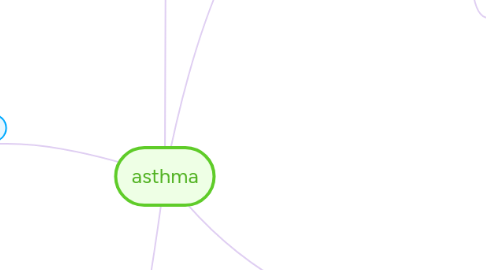
1. action plan
1.1. med
1.1.1. Long term
1.1.1.1. anti- inflam
1.1.1.1.1. immunomodulators
1.1.1.1.2. leukotriene modifiers
1.1.1.1.3. cortisol
1.1.1.2. broncho dilator
1.1.1.2.1. LABAs
1.1.1.2.2. prednisolone
1.1.1.2.3. theophylline, aminophyline
1.1.2. acute
1.1.2.1. SABA
1.1.2.2. inhale corticosteroid
1.1.2.3. hydrocortisone
1.2. http://www.asthma.ca/adults/control/pdf/AsthmaActionPlan_ENG.pdf
2. triggers
2.1. intrinsic
2.1.1. exercise
2.1.1.1. endurance training
2.1.1.1.1. hyperventilation
2.1.1.1.2. dehydration, dry cold air
2.1.2. hyperventilation
2.1.3. nervous system
2.1.3.1. ANS imbalance
2.1.3.1.1. PNS>SNS
2.1.3.2. vagal n hyperact
2.1.3.2.1. lower HR
2.1.3.3. NANC
2.1.3.3.1. broncho airway constriction
2.1.3.3.2. reflex broncho constriction
2.1.3.3.3. muscussecretion
2.1.4. psychosocial
2.1.4.1. anxiety, stress
2.1.4.1.1. NO, ect
2.1.4.2. support
2.1.4.2.1. buffer stress
2.1.5. allergic
2.1.5.1. immune system hyperact.
2.1.5.1.1. IgE
2.1.6. Hormone fluctuation
2.1.6.1. decrease cortisol level
2.1.6.1.1. lowest 4am
2.1.6.2. estrogen
2.1.6.2.1. regulate β2-agonist receptor fx
2.1.7. exaggerate inflam process
2.1.8. infection
2.1.8.1. viral infection
2.1.8.1.1. epithelial damage
2.1.9. nocturnal
2.1.9.1. gravity to lung
2.1.9.1.1. greater resistance
2.1.9.2. COPD
2.1.9.2.1. deteriorated lung fx
2.1.9.3. circadian rhythm
2.1.9.3.1. higher vagal n act.
2.1.9.3.2. decrease cortisol level
2.2. extrinsic
2.2.1. seasonal
2.2.1.1. grass, pollen,
2.2.2. work environment
2.2.2.1. harmful chemicals
2.2.3. home
2.2.3.1. dust
2.2.3.2. animal dander
2.2.3.2.1. 2cat, 1dog
2.3. http://www.ncbi.nlm.nih.gov/pmc/articles/PMC1069088/table/t2/
3. single mom, 1 child, clerk, only mom talking care of her
4. 40% female during premenstrual cycle
5. sore throat, yellow sputum
6. trouble of sleep
7. asthma categories
7.1. mild
7.2. moderate
7.3. severe
8. inflammation
8.1. remodelling of airway walls
8.1.1. increase thickening of wall
8.1.1.1. hyperplasia
8.1.1.1.1. globet cells
8.1.1.2. fibrosis
8.1.1.2.1. impair gas exchange
8.1.1.3. submucosal gland
8.1.1.3.1. increase mucus secretion
8.1.2. incomplete reversibility
8.2. immune cell mediators
8.3. immune cell reponse
8.3.1. Th1, Th2
8.3.1.1. inteleukines
8.3.1.1.1. IL4, IL5
8.3.2. mast cell
8.3.2.1. IgE receptors
8.3.3. B cell
8.3.3.1. IgM, IgG
8.4. broncho hyperreact.
8.4.1. smooth m constriction
8.4.1.1. airway narrowing
8.4.1.1.1. increase airway resistance
9. type of asthma
9.1. childhood
9.1.1. poor food dyversity
9.1.1.1. less exposure to allergen
9.1.2. contact tobacco smoke before birth
9.1.2.1. impair nervous system ?
9.1.3. gene predisposition
9.2. adult onset
9.2.1. obesity
9.2.1.1. diet
9.2.1.1.1. low vege/fruit intake
9.2.2. hormone fluction
9.2.2.1. puberty
9.2.2.2. menopause
9.2.2.3. pregnancy
9.2.2.4. estrogen supplement
9.3. occupational
9.3.1. exposure to work environment chemical
9.4. EIA
9.4.1. endurance training
9.5. seasonal
9.6. allergic
9.7. bronchial inflam
9.8. nocturnal
9.9. severe
10. higher PaCO2
10.1. Hypercapnia
10.1.1. increased breathing rate
10.1.1.1. increased energy consumption
10.1.1.1.1. increased O2 demand
11. respiratory failure
11.1. reduce peak flow
12. lower PaO2
12.1. hypoxia
12.1.1. anaerobic glycolysis
12.1.1.1. increase [H+]
12.1.1.1.1. respiratory acidosis
12.1.2. ischemic CNS response
12.1.2.1. increase BP + HR
12.1.2.1.1. increased workload of the heart

